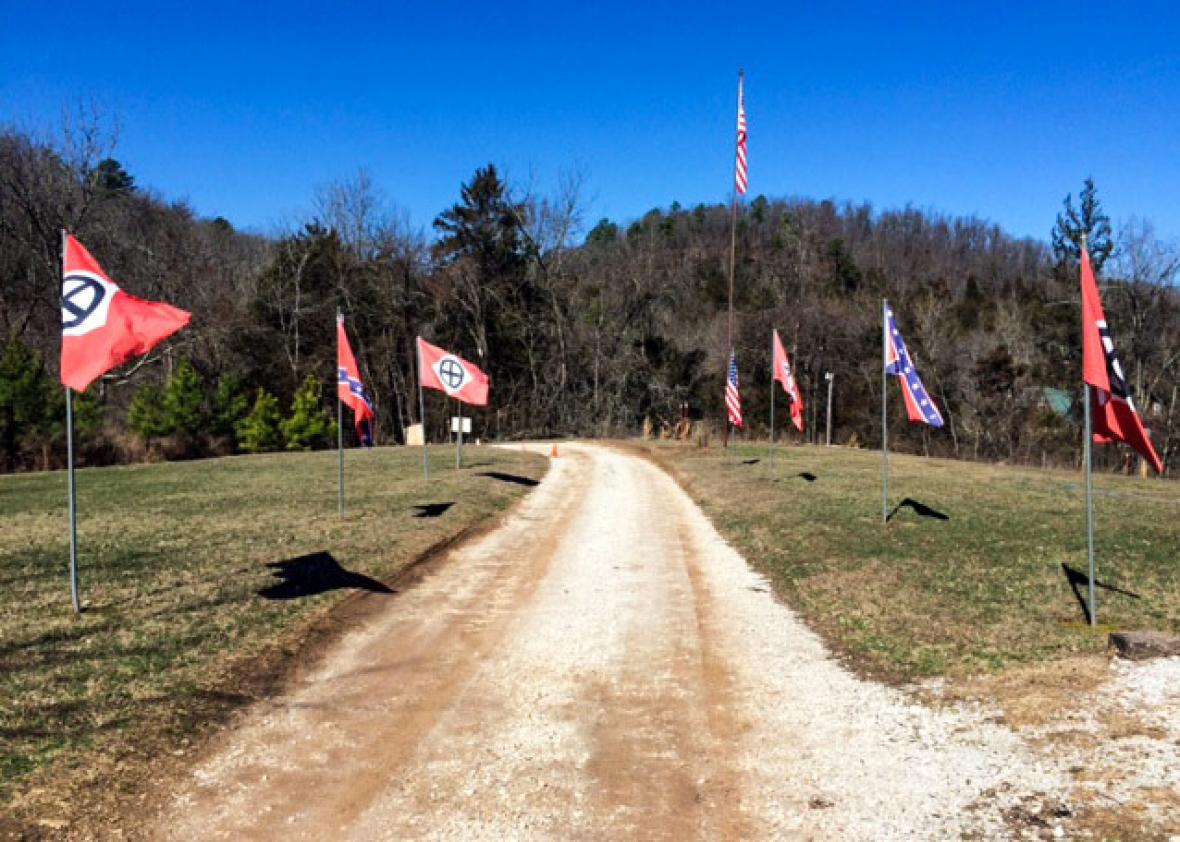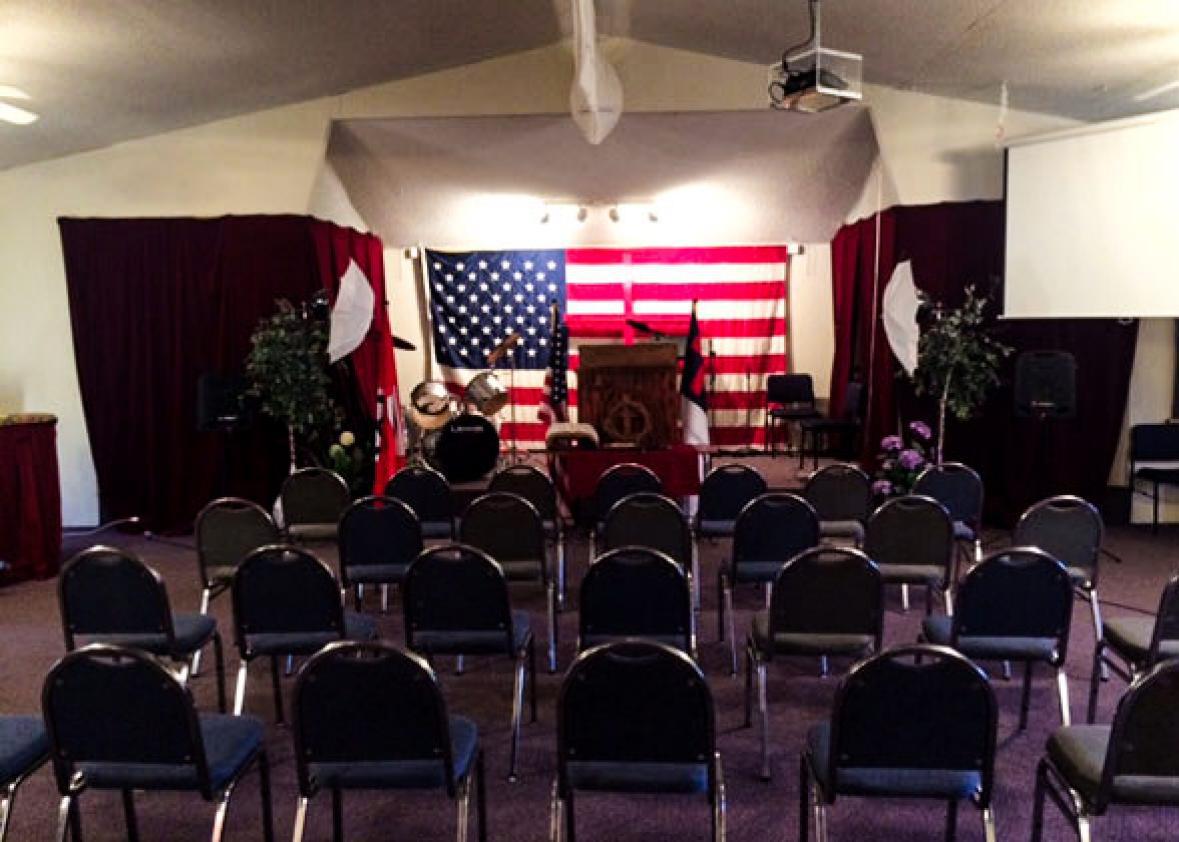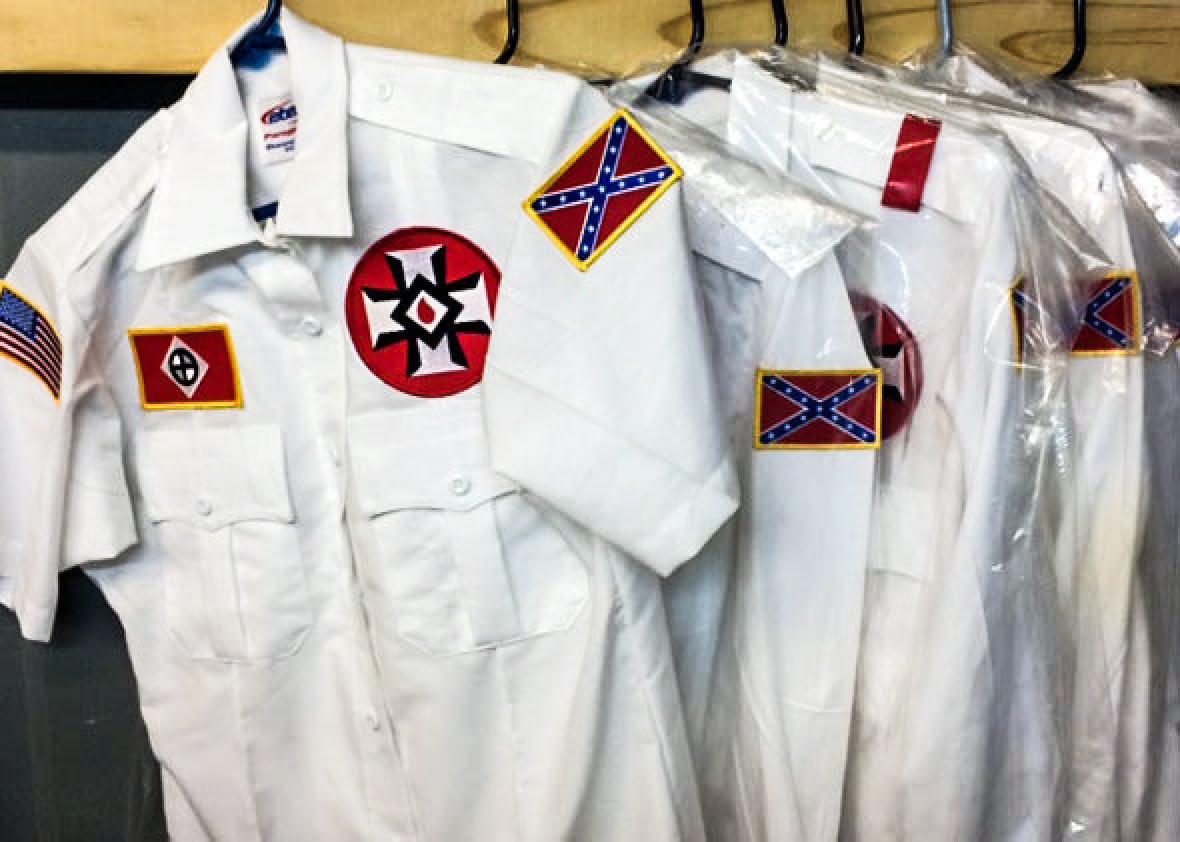HARRISON, Arkansas—Whether or not you think his policies are explicitly racist, President Donald Trump has brought white nationalism to the fore of the American zeitgeist. Efforts to make white nationalist dogma mainstream, though, didn’t start with Richard Spencer’s repackaging of upper-class racism as a think tank, or Steve Bannon whispering in President Trump’s ear.
In the Ozarks, the normalization of white supremacist ideology started decades ago. The credit goes largely to Thomas Robb, who in 1989 took control of David Duke’s Knights of the Ku Klux Klan. The rebranding began with one of his first acts in charge. Instead of the creepy Grand Wizard moniker, Robb opted for the urbane: national director.
He wears suits and conducts himself with the mannered decorum of a news anchor, which is how he appears on daily KKK webcasts. One such program, called White Resistance News, features a backdrop of the U.S. Capitol. Robb is clean-cut, with a grandpa’s thinning combover. He markets himself and his group as Christian. He does not advocate violence.
Despite the terror the letters “KKK” can invoke, Robb makes white supremacist ideology sound almost bland. For example: “I’m a white person, my family is white,” he says. “I want to preserve their culture, their heritage. I want to have a future for my children and my grandchildren.”
Despite Robb’s polished façade, his websites and marketing materials contain plenty of raw hate. On his web radio station, for example, lyrics to a heavy metal song invoked an old chestnut of KKK dogma: smears against minorities as sexually violent (particularly toward white women) followed by the call “these migrants must be enslaved.” The Southern Poverty Law Center, meanwhile, has gathered a dossier on Robb which includes a number of his most damning proclamations, including: “When the Negro was under the natural discipline of white authority, white people were safe from the abuse and violence of the Negro, and the Negro was also safe from himself.”

Bret Schulte
Though Robb’s compound sits some 15 miles away from Harrison—up a hill from an unincorporated heap of marred trailers, dirt roads, and despair called Zinc, pop. 103—his Harrison address, and its history as a Sundown Town, has given the Boone County seat an unsavory reputation, even within Arkansas. In November, the U.K.’s Daily Mirror dubbed it “the most racist town in America.”
Robb calls the KKK “the first alt-right organization in the world.” He has erected billboards throughout the area that convey such messages as “Diversity is a code for #whitegenocide.” One that advertised a Robb web property, www.whiteprideradio.com, featured a picture of a sorrowful white girl and the note, “It’s not racist to [heart] your people.” Other hate groups have picked up on Robb’s idea of splattering racist messages along local roadways. The League of the South—a group set up to push Southern secession, because that worked out so well last time—set up shop nearby and launched its own billboard urging passersby to “#Secede.” (Trump’s election has not cooled the group’s desire to #secede: It erected a similar billboard in Tennessee a month ago.)
That Harrison, a town of just 13,000, is 96 percent white and located in the Ozark hills of a former Confederate state might make it an unsurprising breeding ground for white supremacists. But for the last 15 years, civic leaders have battled Robb for the town’s reputation. Organized as the Community Task Force on Race Relations, they have launched their own billboards, media-outreach campaigns, and diversity-themed events.
For years, the task force pitted what it thought were mainstream ideals of pluralism against the segregationist goals of the KKK. It enjoys the endorsement of business and city leaders. At a task force meeting in March, about a dozen beaming members, white and black, piled together for a group photo in the lobby of Harrison’s Chamber of Commerce to celebrate their latest victory: The town had won the Dream Keeper Award for 2016, presented by the state’s Martin Luther King, Jr. Commission for notable efforts to improve race relations, particularly among young people.
But if Harrison is any guide, establishment endorsements and task forces aren’t enough to push back the rising tide of white nationalism. Trump demolished the competition in Boone County, winning 76 percent of the vote—16 points higher than his already-sizable statewide victory. Task force members point out that the area is historically Republican, but Trump also topped Mitt Romney’s 2012 victory here by 4 points, and that was an election that had fewer and less-established third-party candidates to potentially take away from the GOP’s totals.
For the task force, Trump’s local victory came as no surprise, but even the group that has spent years fighting white nationalism reacted with shock on election night. “I honestly think that this shows Harrison is no different from the rest of the country,” said Layne Ragsdale, one of the task force’s founders. “This is not a Harrison issue. It’s an American issue.” Ragsdale said that she now feels less alone in the fight, but that’s not necessarily a good thing. The fact is the task force has been relatively powerless to stop Robb, whom since the election of Trump, has had good reason to crow.
Robb, who has affixed a Trump sign outside the entrance to his compound, says his membership is growing, though he refuses to divulge numbers. He believes Trump won because the alt-right represents a purer brand of conservativism than did the Neo-Cons of the George W. Bush years. “’America First’ is a conservative value,” he said. “Diversity is not our strength. Diversity will kill us.”
Robb’s compound itself reflects his effort to preserve the core Klan mission of white supremacy while trying to sell the group to the soccer-mom crowd as a family-centric Christian organization. Klan imagery drapes the walls of the drab wooden building that serves as the KKK’s main office, including a 1922 panorama of hooded men circling a burning cross. But off a back hallway, a playroom is filled with tattered toys. Bicycles and faded Little Tyke playgrounds dot the grounds, along with a Confederate battle flag waving over a playset. About 20 kids come each year for an annual summer camp. A new building is under construction that will house classrooms and a multimedia center for youths training for careers such as law and politics.

Bret Schulte
Yet, for all of Robb’s outreach via billboards, newsletters, and an array of web properties, his viewership numbers on YouTube are dismal. A recent check showed just 31 subscribers. Robb insisted numbers don’t indicate his influence but repeatedly declined to provide any evidence of something that might.
“He claims a large following, but it’s anyone’s guess,” says Kevin Cheri, a leader of the task force. “It’d be interesting to see [Klansmen] identify themselves but with the exception of Robb you don’t really see them.” Cheri, who is black, says he feels safe in Harrison and doesn’t believe it’s any more or less racist than other towns. Whether or not Robb is merely attempting to piggyback off of the success of the alt-right with his latest media pushes, the town’s story is instructive for what a prominent white nationalist presence does to a place.
The specter of the Klan, and the reputation of Harrison, has long struck fear into people throughout portions of the state. Black visitors often leave town before dark, if they visit at all. The presence of the Klan hurts the town in other ways. IHOP once passed on opening a restaurant in Harrison because, as former mayor Jeff Crockett says, the restaurant chain worried black employees wouldn’t live there.
The task force has continuously fought back for this image. In 2012 and again in 2014, the group succeeded in bringing to Harrison two Non-Violence Youth Summits, an event that is usually held in the much larger city of Little Rock and is sponsored by the Arkansas MLK Commission.
In between the two youth summits, the first Klan billboard appeared in Harrison saying, “Anti-racist is a code word for anti-white.” Crockett met with the press and about 30 concerned residents in front of the sign. “The important thing is that we show the outside world this is not Harrison,” Crockett said. (The sign, of course, went viral.)
When Crockett lost his re-election bid, he told the local newspaper that being out front on diversity was at least part of the reason. Robb views Crockett’s loss as an expression of local support for his pro-white views. He thinks the alt-right is winning the hearts and minds of Harrison—and with the election of Trump, Americans everywhere.
The task force, meanwhile, believes its efforts to change Harrison’s reputation have not been in vain. Rather, it views itself as on the vanguard of a fight the rest of the country is just joining. “We’re finding out here and all around the country that this problem doesn’t [just] get fixed,” says George Holcomb, a former journalist who once covered the task force with some skepticism before joining it in retirement. “This is something you keep working on.”
